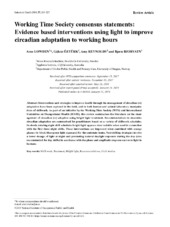| dc.contributor.author | Lowden, Arne | en_US |
| dc.contributor.author | Öztürk, Gülcin | en_US |
| dc.contributor.author | Reynolds, Amy | en_US |
| dc.contributor.author | Bjorvatn, Bjørn | en_US |
| dc.date.accessioned | 2020-03-31T12:51:25Z | |
| dc.date.available | 2020-03-31T12:51:25Z | |
| dc.date.issued | 2019-01-31 | |
| dc.Published | Lowden A, Öztürk G, Reynolds A, Bjorvatn B. Working Time Society consensus statements: Evidence based interventions using light to improve circadian adaptation to working hours. Industrial Health. 2019;57(2):213-227 | eng |
| dc.identifier.issn | 1880-8026 | |
| dc.identifier.issn | 0019-8366 | |
| dc.identifier.uri | https://hdl.handle.net/1956/21641 | |
| dc.description.abstract | Interventions and strategies to improve health through the management of circadian (re)adaptation have been explored in the field, and in both human and animal laboratory manipulations of shiftwork. As part of an initiative by the Working Time Society (WTS) and International Committee on Occupational Health (ICOH), this review summarises the literature on the management of circadian (re)adaption using bright light treatment. Recommendations to maximise circadian adaptation are summarised for practitioners based on a variety of shiftwork schedules. In slowly rotating night shift schedules bright light appears most suitable when used in connection with the first three night shifts. These interventions are improved when combined with orange glasses (to block blue-green light exposure) for the commute home. Non-shifting strategies involve a lower dosage of light at night and promoting natural daylight exposure during the day (also recommended for day shifts) in acordance with the phase and amplitude response curves to light in humans. | en_US |
| dc.language.iso | eng | eng |
| dc.publisher | National Institute of Industrial Health | eng |
| dc.rights | Attribution CC BY-NC-ND | eng |
| dc.rights.uri | https://creativecommons.org/licenses/by-nc-nd/4.0/ | eng |
| dc.subject | Shift work | eng |
| dc.subject | Treatment | eng |
| dc.subject | Bright light | eng |
| dc.subject | Recommendations | eng |
| dc.subject | Field studies | eng |
| dc.title | Working Time Society consensus statements: Evidence based interventions using light to improve circadian adaptation to working hours | en_US |
| dc.type | Peer reviewed | |
| dc.type | Journal article | |
| dc.date.updated | 2020-01-29T14:17:13Z | |
| dc.description.version | publishedVersion | en_US |
| dc.rights.holder | Copyright 2019 National Institute of Occupational Safety and Health | |
| dc.identifier.doi | https://doi.org/10.2486/indhealth.sw-9 | |
| dc.identifier.cristin | 1785414 | |
| dc.source.journal | Industrial Health | |

